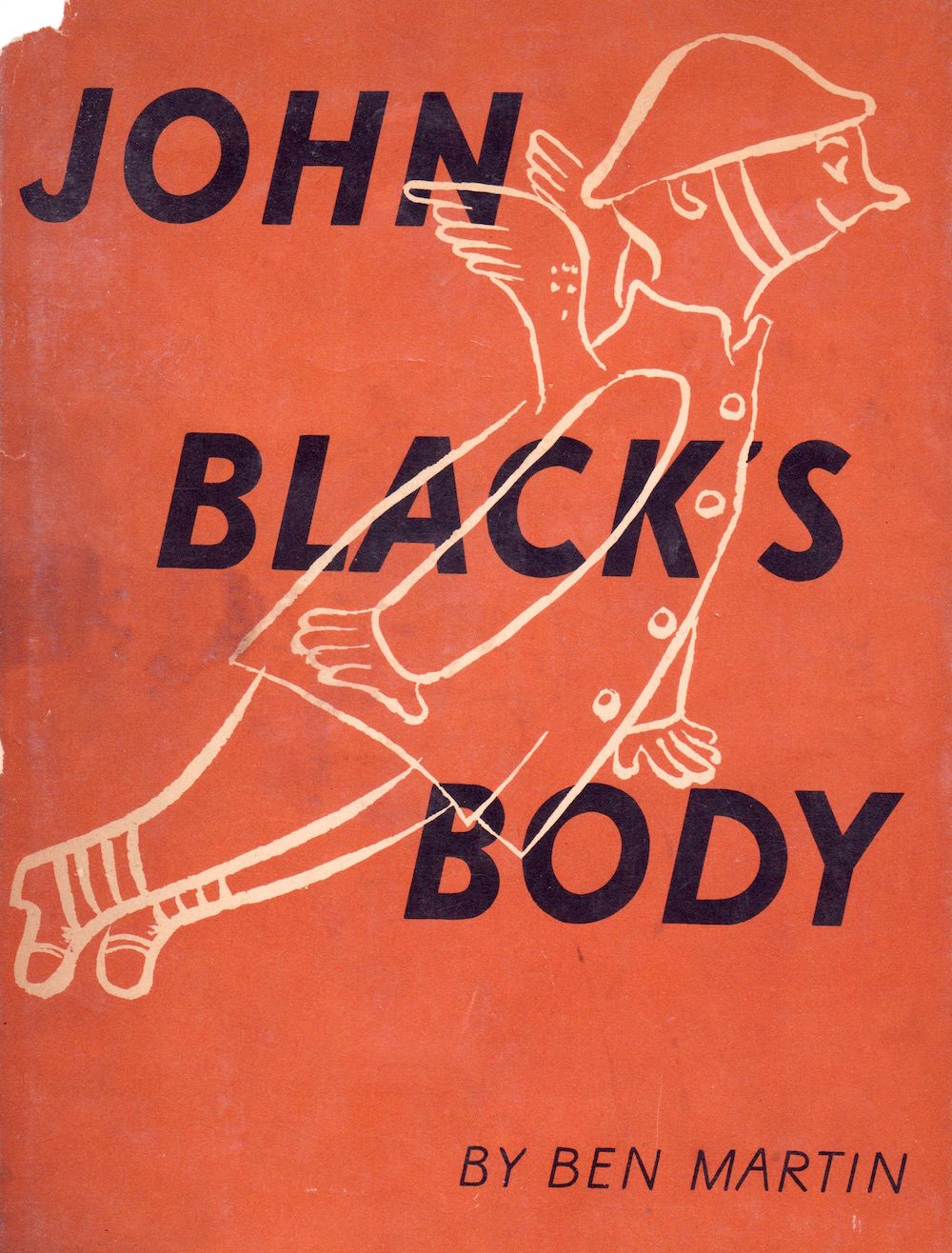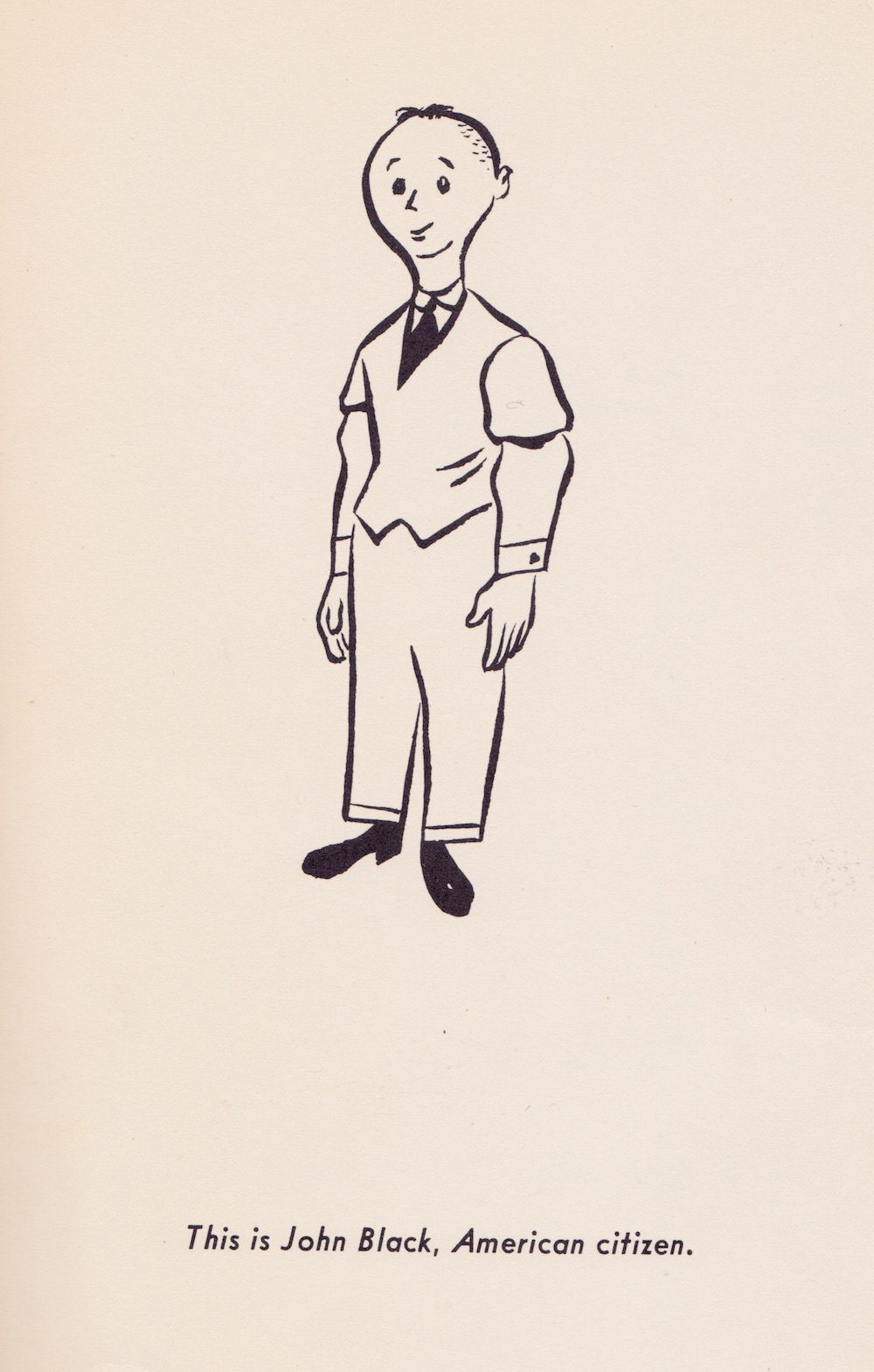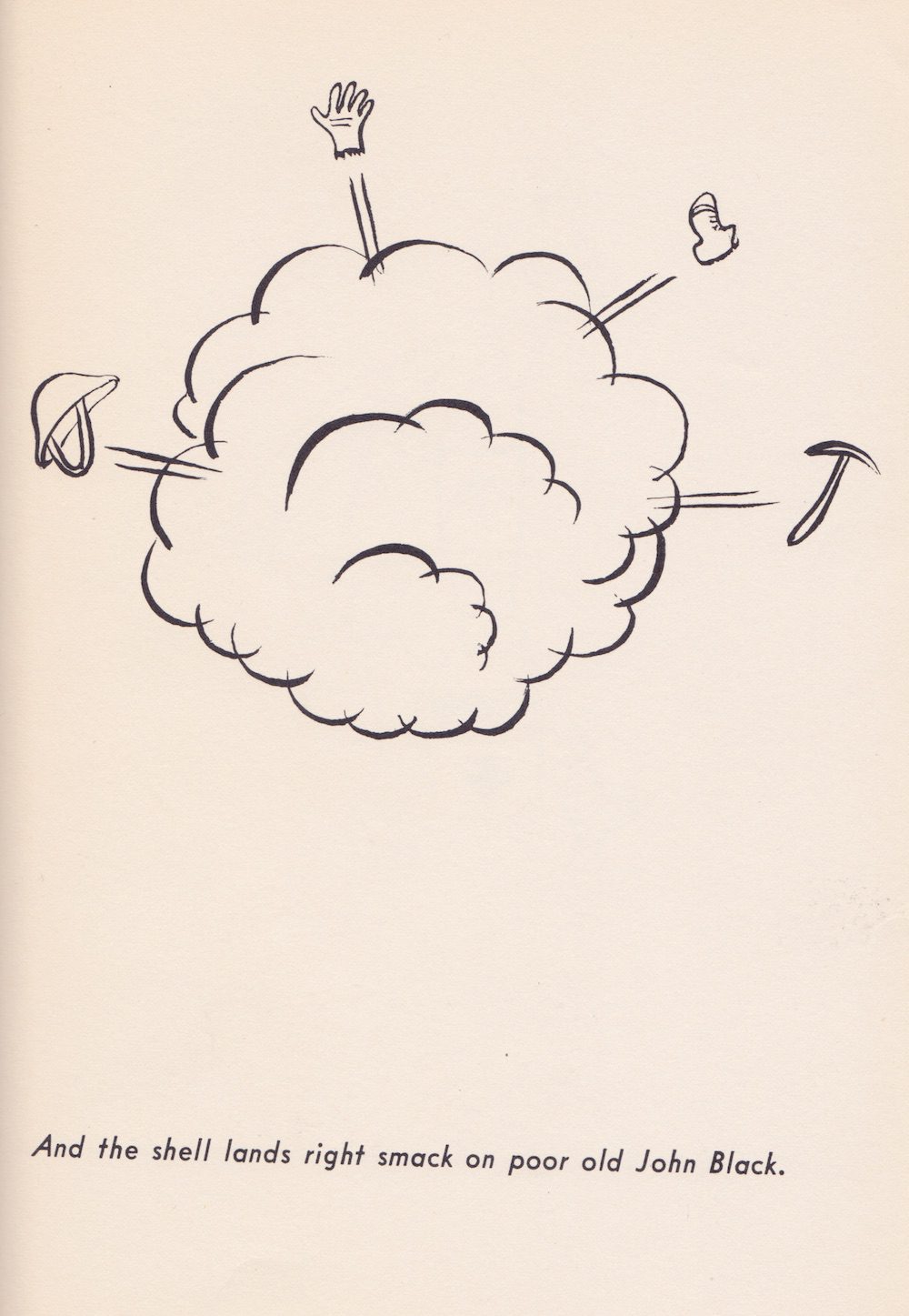In the imagined scenario wherein my apartment burns to the ground and I lose all my worldly possessions, there are just a few things I would miss—family photographs (of course), an old wooden trunk my grandmother reupholstered and that I used to store my toys as a child, and the book, John Black’s Body. I discovered it just over a year ago in the graphic novel section at The Strand. You know, in the shelves behind the stairs on the second floor that usually include anthologies of Sunday cartoons. Not the place you’d look for R. Crumb or Saga, but where you’d thumb through—but never buy—reissued collections of Gasoline Alley or Little Lulu.
Discovering this book was one of those rare but magical used bookstore moments that—for better or worse—keeps my book obsession healthy and motivated. I took it out yesterday and fell in love with it all over again.
 John Black’s Body is just a fantastic piece of work. It really is. At first read, it seems like an early version of what is now considered comics journalism, but it’s more a work of comics satire, something in rare supply nowadays. Published in 1939, the inaugural year of World War II, it wryly assesses the value of the average American citizen—John Black—in terms of dollars invested in his body, and what return the country gets from its financial stake. Parts of the investment include butter, eggs, milk and toothpaste ($15,000), medical attention ($1,750), and education ($10,000). But it points to the biggest expense as the money spent by the U.S. government in misinforming him through various media and press channels (a whopping $1,000,000). Overall, the total investment—which also includes haircuts and tobacco—in John Black’s body is $1,029,150.18.
John Black’s Body is just a fantastic piece of work. It really is. At first read, it seems like an early version of what is now considered comics journalism, but it’s more a work of comics satire, something in rare supply nowadays. Published in 1939, the inaugural year of World War II, it wryly assesses the value of the average American citizen—John Black—in terms of dollars invested in his body, and what return the country gets from its financial stake. Parts of the investment include butter, eggs, milk and toothpaste ($15,000), medical attention ($1,750), and education ($10,000). But it points to the biggest expense as the money spent by the U.S. government in misinforming him through various media and press channels (a whopping $1,000,000). Overall, the total investment—which also includes haircuts and tobacco—in John Black’s body is $1,029,150.18.
Despite the magnitude of the story, the inside cover boasts that it says it all with a mere 48 pictures and 403 words. It promises, “You can read it in three minutes, but you will return to it again and again, and you will never forget it.” Each of the 48 drawings has its own page and all have a loose and inky exuberance similar to Al Hirschfeld, William Gropper, or Art Young, all contemporaries of the author, Ben Martin. It reads with the ease of a children’s book, yet the political content is clearly crafted for the tax-paying adult. And it really takes more like four minutes to read. (I timed it.)
The story takes a nose-dive into irony as soon as Martin points out that, despite all this investment in his body, John Black still can’t find a job. And here’s where the story blossoms into a familiar, contemporary bleakness. As with today’s economic  struggles, no one seems to know what to do to resolve John Black’s unemployment problem—not the businessmen, the college professors, or other civic and national leaders. But the politician has an idea—he declares war! And who gets to fight this war? John Black, of course.
struggles, no one seems to know what to do to resolve John Black’s unemployment problem—not the businessmen, the college professors, or other civic and national leaders. But the politician has an idea—he declares war! And who gets to fight this war? John Black, of course.
Everyone cheers because stocks go up, and for those who are not fighting the war life is better. However, John Black the soldier is hungry, tired, and scared. Until…
One day the enemy brings up a gun worth $50,000 and fires a shell worth $300 and the shell lands right smack on poor old John Black. What they can find of John they gather up in a bucket and they bury him under a $0.98 cross. (With his name spelled wrong.)…And everybody else spends the rest of his life working to pay back the money that was tied up in John Black’s body.
Like I said, not exactly a children’s book.
*
Not much is known about the book’s author and illustrator, Ben Martin. He doesn’t appear in any cartoonist anthologies I’ve seen, and he certainly isn’t canonized within Wikipedia. Still, I was able to dredge up a single newspaper article about Martin from 1954, a feature on his Christmas-themed serial comic strip, Heavenly Daze.
 In the article, he’s credited as having published three books, all before age thirty: John Black’s Body (1939); Mr. Smith and Mr. Schmidt (1940), a comparison between the average American and the average Nazi; and Alfred (1940), a story about a dachshund who wanted to be a trained seal. He was born in Oakland, California, later graduated from the University of California, and finally settled in New York City. For years he held an editorial position at the Herald Tribune, but he also did time as a news editor for a Philadelphia television station. In other moments he was a playwright, and a cartoonist. His works have been published in the Saturday Evening Post, Colliers, Vogue, Punch, and a ton of others. Strangely, the article shares that he was in no way fond of the great outdoors, and even found the sun to be irritating. And that’s what we know about Ben Martin.
In the article, he’s credited as having published three books, all before age thirty: John Black’s Body (1939); Mr. Smith and Mr. Schmidt (1940), a comparison between the average American and the average Nazi; and Alfred (1940), a story about a dachshund who wanted to be a trained seal. He was born in Oakland, California, later graduated from the University of California, and finally settled in New York City. For years he held an editorial position at the Herald Tribune, but he also did time as a news editor for a Philadelphia television station. In other moments he was a playwright, and a cartoonist. His works have been published in the Saturday Evening Post, Colliers, Vogue, Punch, and a ton of others. Strangely, the article shares that he was in no way fond of the great outdoors, and even found the sun to be irritating. And that’s what we know about Ben Martin.
More is available on the book’s publisher, Vanguard Press, which was founded in 1926 with a modest grant from the American Fund for Public Service. The small press, eventually absorbed by Random House in 1988, published titles throughout the 1920s and 30s on communist and socialist theory and other left-of-center topics. Its ambition was to introduce works that were otherwise unpublishable by more mainstream presses, and at affordable prices. It makes sense that John Black’s Body found a home at Vanguard, and was available for $1.
*
So what would today’s version of John Black’s Body look like? It’s tricky to compare the 1939 dollar investment with now. In strict terms of inflation, the investment in John Black’s body of 2015 would be $17,572,258.07, and that’s just ridiculous. What we can say is that instead of fighting a war to dig the country out of financial turmoil, the modern John Black is borrowing money to pay for his own education, health care, and rapidly inflating food costs, and paying it back plus interest. Today’s John Black is a debt soldier. And so, the version of John Black’s Body now would read like the messaging of the Occupy Wall Street movement. (Interestingly, there’s a drawing in the book that depicts John Black holding a paper that reads “99%”.)
And so, the version of John Black’s Body now would read like the messaging of the Occupy Wall Street movement. (Interestingly, there’s a drawing in the book that depicts John Black holding a paper that reads “99%”.)
Unfortunately, we are in short supply of comic works that tell the story of a contemporary John Black. Most are similar to the “for dummies” variety of graphic economic criticism like Economix: How Our Economy Works (and Doesn’t Work), in Words and Pictures (2012). Others stick to a more journalistic approach—telling the story of what happened during the Occupy Wall Street days like The Beginning of the American Fall (2012). And then there’s Bumf (2014), Joe Sacco’s recent work of absurdist political satire.
This is not to say these works aren’t worth reading. They all are! But there’s a unique value in creating character-driven political narratives like John Black’s Body that we don’t see much in comics today. Characters like John Black, although can be so generalized as to be unrelatable, create clear and simple opportunities to empathize with the affect that politics, economics and war has on our bodies and on our physical well-being. Maybe this is a scary thing to admit to—that our bodies, like John Black’s, are in danger and are at the mercy of decisions that are out of our control. This is what I find most brave and compelling about this book, and why if there is a fire in my apartment someday (knock on wood) I’ll try to grab it.





One response
Dear Monica,
I enjoyed reading your post of December 29, 2015. Please do drop by my website. (I only invite people who I think will genuinely enjoy it.) It’s alhirschfeld.com .
A happy new year to you,
Margo Feiden
Click here to subscribe today and leave your comment.